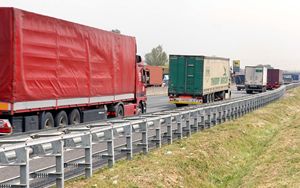(Finance) – The Commission today presented a series of measures to make the freight transport more efficient and sustainable, improving the management ofrailway infrastructureoffering greater incentives to trucks emissions and improving information on greenhouse gas emissions from freight transport. The aim is to increase the efficiency of the sector, helping it contribute to the goal of reducing transport emissions by 90% by 2050, as set out in the European Green Dealwhile allowing the EU single market to continue growing.
The proposal of regulation on the use of railway infrastructure capacity in the single European railway area is based on the industry-driven temporal redesign project. The aim is to better respond to the different needs of the railway sector: stable timetables and advance ticket booking for passenger services and flexible train movements adapted to just-in-time supply chains for shippers.
As for the troad transport A new directive on weights and dimensions has been presented which sets the maximum length, width and height for heavy goods vehicles. In particular, the proposal revises the rules to allow a additional weight for vehicles using zero emission technologies, as they tend to increase the weight of a vehicle. This will incentivize the adoption of cleaner vehicles and technologies. Once the technology develops and i zero-emission propulsion systems will become lighter, also through the use of aerodynamic devices and cabs, cleaner vehicles will benefit from an additional payload compared to conventional trucks.
The dissemination of will also be encouraged more aerodynamic cabins and of others energy saving devicesnot only improving the comfort and safety of drivers, but also increasing the efficiency of zero-emission powertrains, i.e. the mechanism that transmits engine power to propel the vehicle.
The proposal will also clarify the use in the traffic cross borderunder certain conditions of heavier and longer vehicles currently permitted in some Member States. This also means clarifying that Member States which allow i European modular systems (EMS) in their territories will also be able to use them in international operations between neighboring Member States, without the need for a bilateral agreement and without restrictions on crossing a single border. This means that the same amount of goods can be transported in fewer trips.
To encourage the intermodal transport, where goods are transported using two or more modes of transport but with a standardized loading unit (such as a container trailer or other), trucks, trailers and semi-trailers will be allowed to carry additional weight. The extra height will also make it easier to transport high-cube containers in standard vehicles.
The EU Commission has proposed a common methodological approach to allow companies to calculate their greenhouse gas emissions if they decide to publish this information or if they are requested to share it for contractual reasons. The proposed methodology is based on ISO/CEN standard recently adopted for the quantification and reporting of greenhouse gas emissions deriving from the operation of passenger and freight transport chains. Reliable data on door-to-door emissions will enable operators to evaluate their services and enable consumers to make informed choices about transport and delivery options.
The proposals will now be considered by European Parliament and from Advise under the ordinary legislative procedure.
